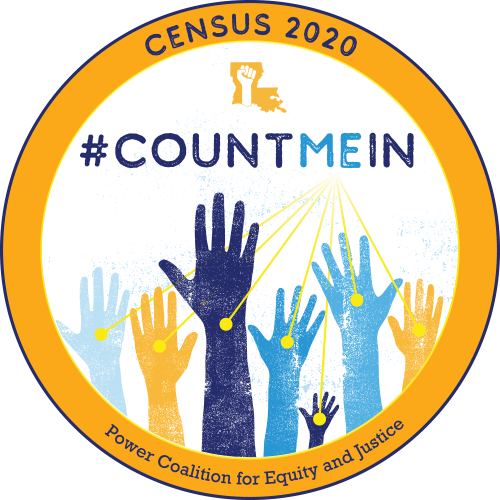Redistricting 2021-2022 Timeline
Redistricting News
|Louisiana Congressional map debate continues in federal court|Hearing underway on attempt to overthrow La.’s congressional map|Jeff Landry targeted Garret Graves in redrawing district map, LA lawmaker testifies|Civil Rights Groups Secure Victory in Landmark Case Challenging Racial Discrimination in Louisiana’s State Legislative Maps |Black Louisianans Enter a New Political Era|Louisiana makes history with new Black congressional district that includes Shreveport|Louisiana Lawmakers Approve Map That Empowers More Black Voters|Advocates to Hold Mass Mobilization Event at Louisiana Capitol Before Redistricting Committee Meeting and Public Hearing|Who will draw new congressional map for Louisiana? Edwards, Landry debate who calls the session|Mark Ballard: Congressional redistricting court fight will likely prove consequential|Voting rights advocates welcome the Supreme Court’s ruling related to La’s redistricting|New majority-Black congressional district in Louisiana closer to reality; see why|US Supreme Court tosses race-based dispute over Louisiana electoral map|Supreme Court allows for Louisiana congressional map to be redrawn to add another majority-Black district|Mark Ballard: Louisiana poised to draw a majority-Black congressional district|Surprise US supreme court ruling could help Democrats take House in 2024|SCOTUS ruling on Alabama’s congressional maps could change voting in Louisiana|Supreme Court ruling could lead to new Louisiana congressional maps — with 2nd Black district|In Supreme Court’s Alabama ruling, Black voter advocates see roadmap to new maps in Louisiana|Voting Rights Activists Look Beyond Supreme Court To People Power|Ashley K. Shelton on the #PutHousingFirst Radio Show|How we fight gerrymandering in the South|Ashley K. Shelton on The Lurie Daniel Favors Show|SCOTUS takes on voting rights case|Campus political groups seek to increase voter turnout|Do Louisiana’s Congressional districts discriminate? Supreme Court hears a related case|Advocates show solidarity as SCOTUS hears redistricting case|Get Out and Vote Canvassing Efforts Begin to Engage Black Voters Statewide|The specter of second-class citizenship|Lawsuits Challenge Second Class Citizenship Status in Southern States.|Advocacy groups to hold briefing prior to International Day of Democracy|Statement from Power Coalition CEO Ashley Shelton on Amicus Brief Release|PCEJ Celebrates Judicial Court Ruling that Declares EBR School Board Plan 22 Null and Void |Judge tosses new Baton Rouge school board maps, gives Wednesday deadline for new ones|Federal judge intervenes with new congressional district map after failure from legislature|Statement from Power Coalition CEO Ashley Shelton on the Special Session |State rep, lawsuit plaintiff & LA SoS react to congressional map redraw order|Federal Court Rules in Favor of Plaintiffs to Block Enacted Congressional Map |Louisiana lawmakers must redraw maps, come up with second majority-minority district, judge rules|A federal judge blocks Louisiana’s congressional map, calling it a racial gerrymander.|Jefferson School Board reverses course, rejects expansion plan; here’s what they did|Historic vote could add minority seats to Jefferson Parish School Board. See the proposals.|Demographer says political map to match Baton Rouge racial balance probably can’t be done|Arguments wrap up in battle to block congressional maps for upcoming elections|Hearing Wraps in Case Challenging Louisiana’s Congressional Map, Judge to Determine Whether New Map Must Be Drawn|Challenge to Lousiana congressional maps opens; groups seek 2nd majority-Black district|Advocates asking federal judge to block recently passed congressional maps|Preliminary injunction hearing set to begin in case challenging Louisiana’s new congressional map|Rally to be held at EBR School Board Office|In fight for more minority representation, Jefferson Parish School Board will add new districts|Residents ask Jefferson Parish School Board for more Black, Hispanic election districts|The Fight for Our Schools Is Not Over|Courting litigation, EBR School Board OK’s election maps that likely preserve White majority|East Baton Rouge School Board Redistricting Special Meeting Results in Approval of Racially Gerrymandered Map|Louisiana Legislature Overturns Governor’s Veto of Map Lacking a Second Majority-Black Congressional District; Civil Rights Groups File Suit Under Voting Rights Act|Lawsuit filed to challenge Congress redistricting map in Louisiana veto override|Civil Rights Groups File Federal Lawsuit Challenging Louisiana Congressional Map|Why Voters Have the Right to a Real Chance at Representation|From Bloody Sunday to the Present, We Must Continue to Resist|Open Letter to Governor Edwards Regarding Redistricting|Governor Vetoes Proposed Congressional Maps|Redistricting Tactics Threaten to Suppress Black Representation in Louisiana|Redistricting Louisiana: What You Need to Know About Redistricting in Louisiana 2022|Clancy DuBos: Louisiana remap plans could be the next Plessy v. Ferguson|Janea Jamison: There is no ‘race blind’ fight in redistricting|Legislative Redistricting Roadshow Comes to Lake Charles On Wednesday, December 15, 2021|Power Coalition Makes Redistricting Grants to Encourage Equitable Redistricting Process|Louisiana north shore residents want out of New Orleans area congressional district|Legislative Redistricting Roadshow Comes to Alexandria On Tuesday, November 9, 2021|Every Voice Matters: Why Redistricting Is Important|Civil rights groups push for redistricting to increase chance of second Black Louisiana lawmaker|Former state legislator: We need competition in Louisiana’s stagnant political system|Civil rights groups demand second minority-majority district in Louisiana
Redistricting Testimony Videos
Email Your Written Statement and Make Your Voice Heard
You can submit written statements, letters, or maps to the House and Senate Governmental Affairs Committees.
Statements emailed to h&ga@legis.la.gov and received 24 hours in advance will be distributed to the committee members prior to the meeting.
Redistricting only happens once every 10 years. Get Involved.
Redistricting is the process by which governments redraw political districts.
It applies to all levels of government where district elections are held, including:
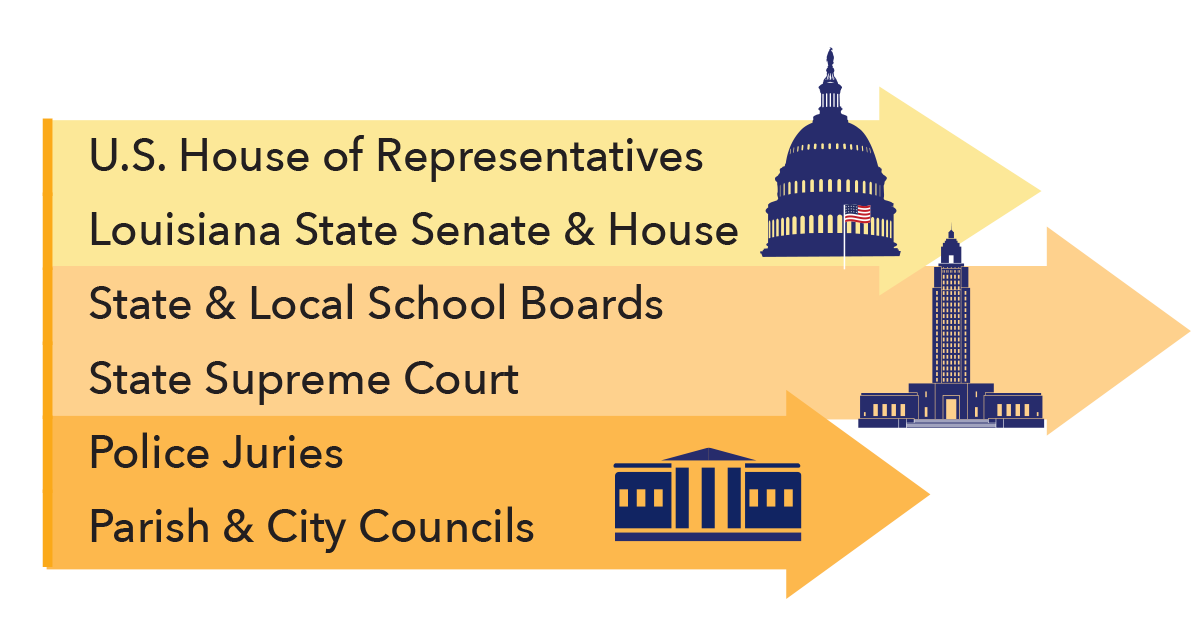
Redistricting happens once every 10 years:
Every year ending in ‘1’ (e.g., 2021), the Louisiana state legislature uses Census data collected the previous year (e.g., 2020) to redraw political maps.
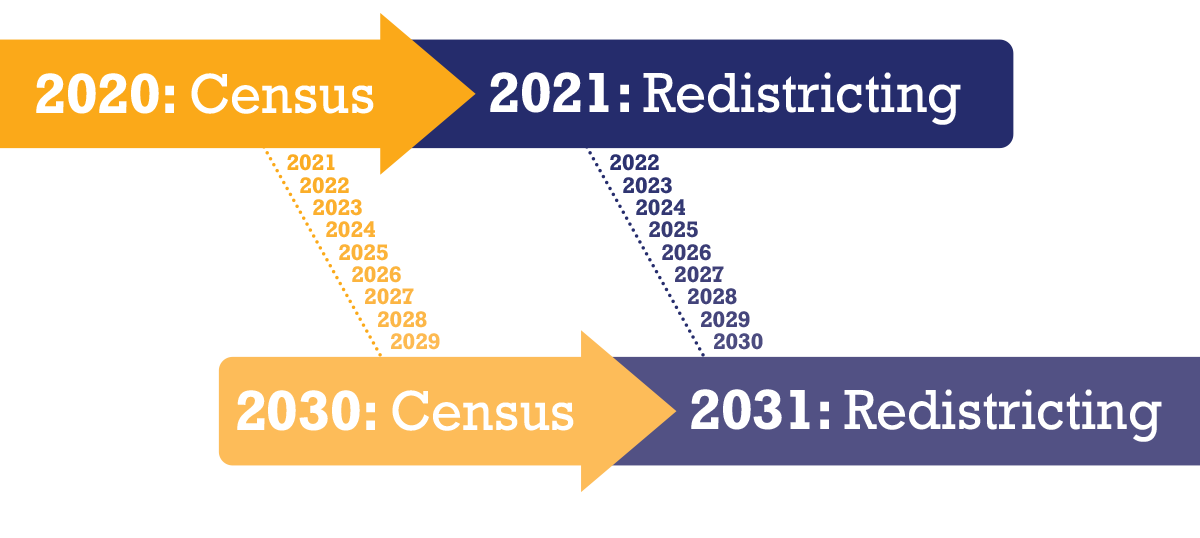
Political districts are supposed to accurately reflect how populations have changed statewide and locally over the past decade, and provide fair representation to each individual and group.
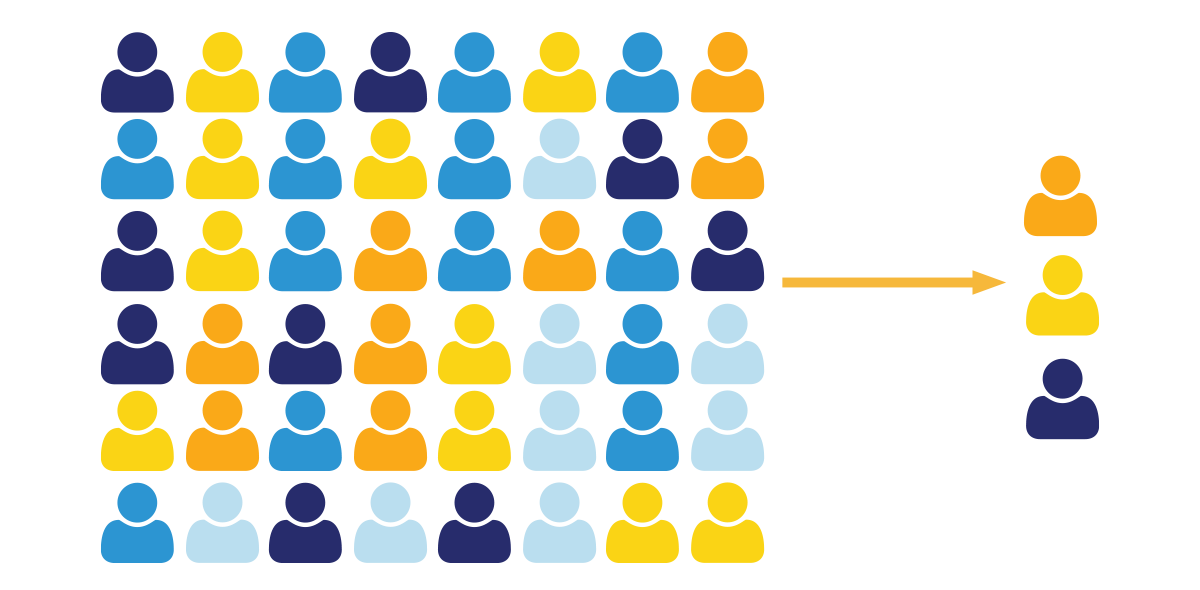
There are three basic redistricting principles:
- Contiguity: Every district has to remain connected–they can’t “jump” from one place to another.
- Compactness: With few exceptions, districts shouldn’t be drawn in extremely odd shapes.
- Communities of Interest:This one can be very subjective, and is the most controversial. Generally, districts should try to keep populations that share interests--e.g., fishing communities--together as much as possible.
- Redistricting plays a critical role in who runs for office, who is elected, and how they vote once they’re in office.
- It’s one of the most important factors in determining who represents you and how they represent you.
who runs for office
who is elected
how they vote
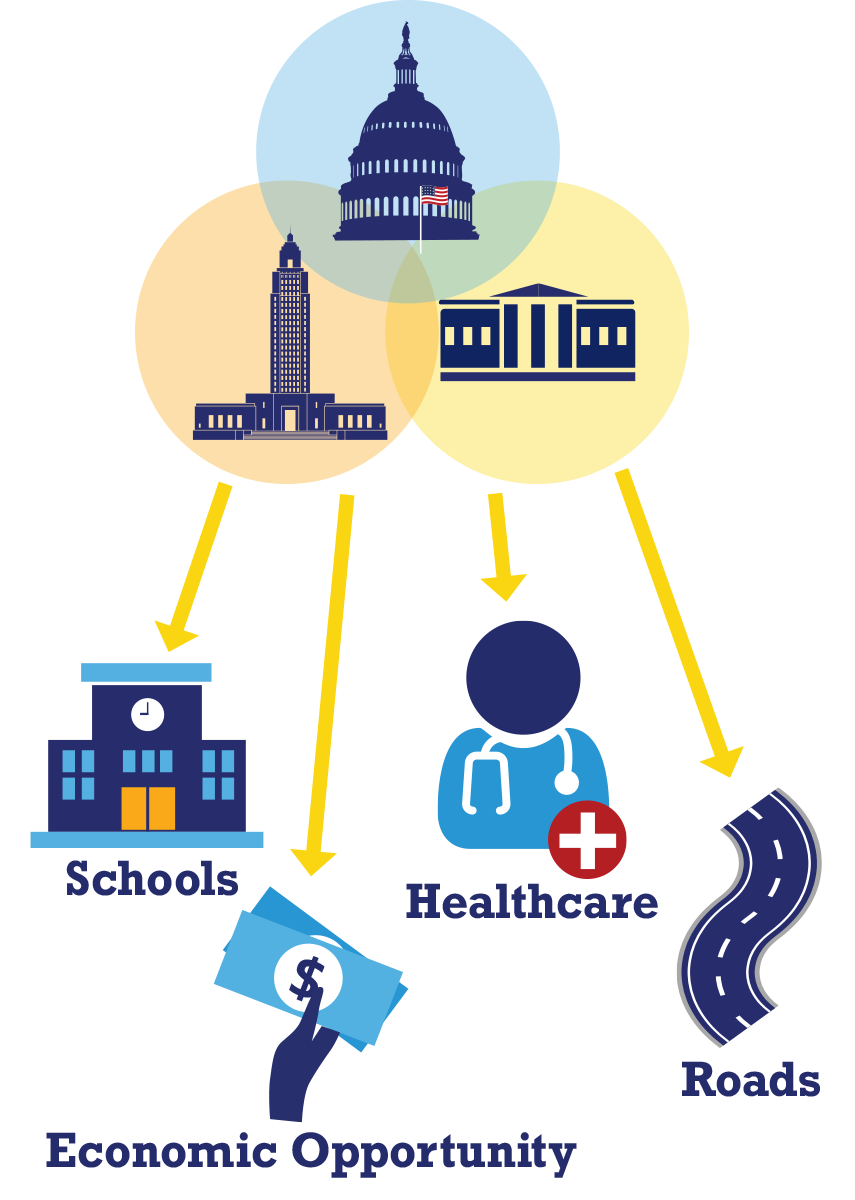
- Your local, state, and federal elected representatives make decisions that impact your everyday life, like economic opportunity, healthcare, schools, roads, and so much more.
- The makeup of a district can significantly influence how and whether elected officials respond to a community’s needs.
- Redistricting only happens once every 10 years, and the policy impact can last even longer. We can’t miss this chance to demand fair and representative districts.
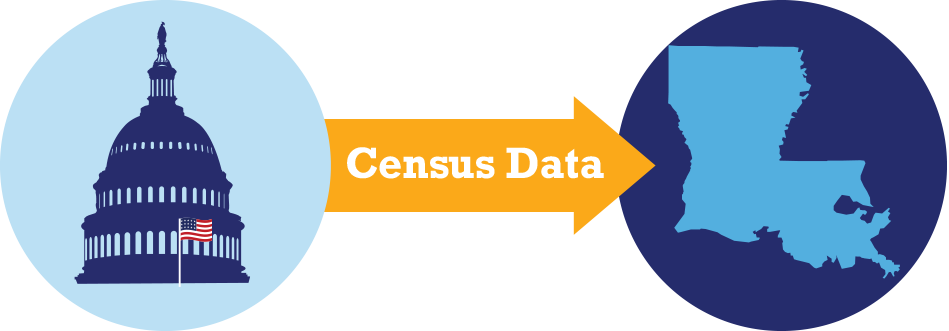
1
The Census Bureau collects population data once every decade, during years ending in ‘0’. That data is then sent to each state, which uses it to inform the redistricting process.
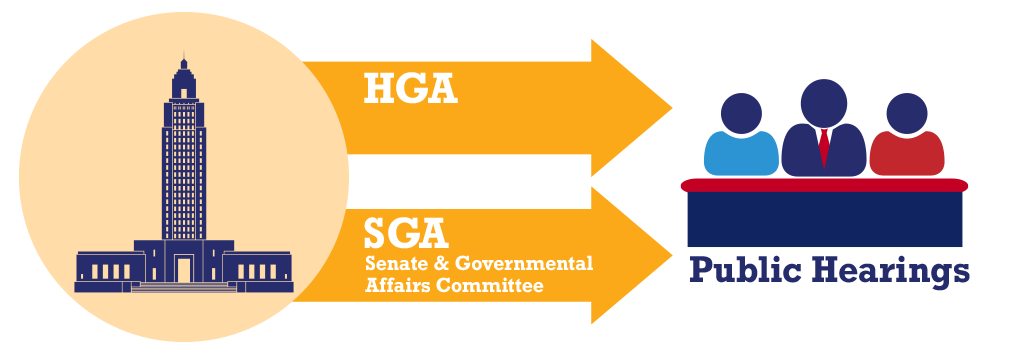
2
The Louisiana legislature holds public meetings on redistricting. Those meetings are usually run by the two committees that oversee redistricting in the legislature--
House & Governmental Affairs (HGA) and Senate & Governmental Affairs (SGA).
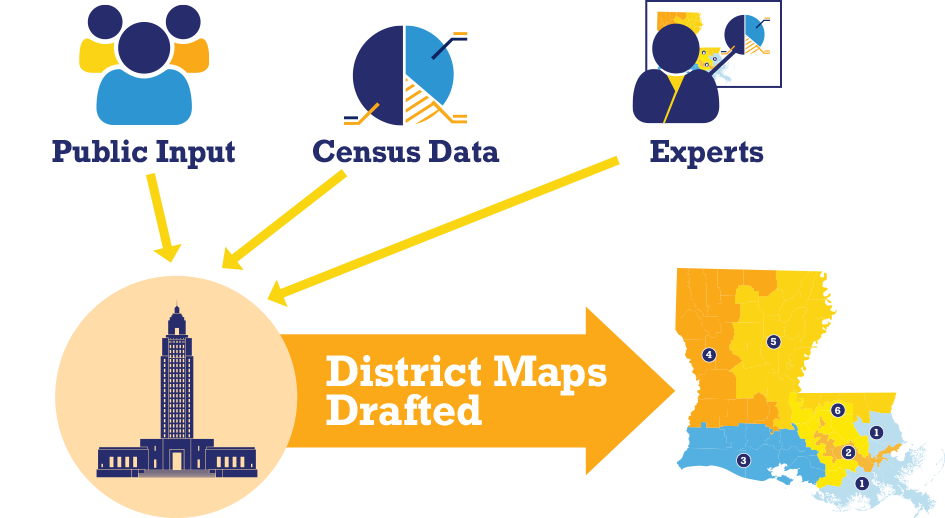
3
The state legislature relies on Census data, public input, and experts to draft district maps
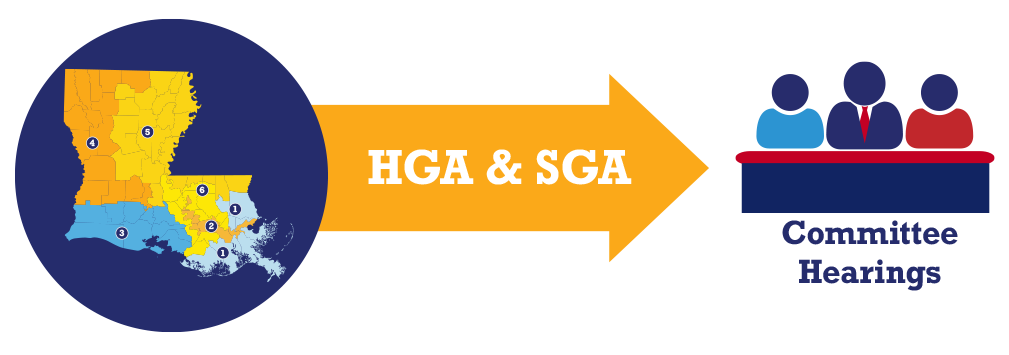
4
The House & Governmental Affairs (HGA) committee and Senate & Governmental Affairs (SGA) committee each hold hearings on proposed district maps. Any proposed map must be approved by a majority of the committee members in order to go to a vote on either the House or Senate floor.
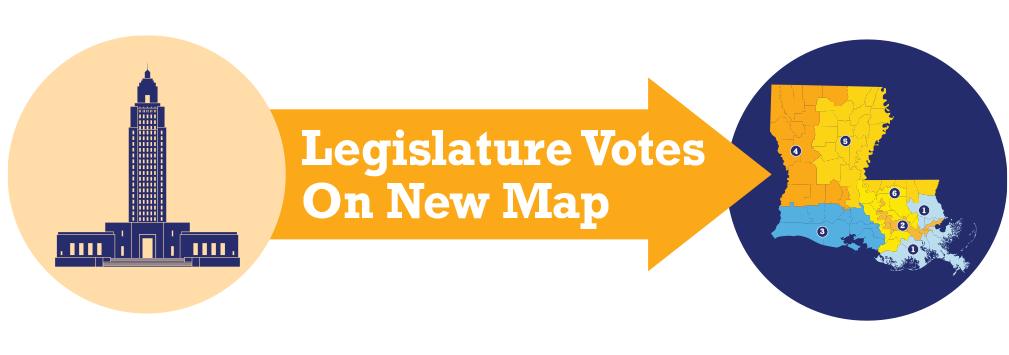
5
When either HGA or SGA pass a map, it goes to a vote on either the House or Senate floor. When a majority of each chamber then approves a map, the two different versions (House and Senate) must be reconciled to create a single map that needs to get approved by both chambers. The final map goes to the Governor’s desk to be signed or vetoed.
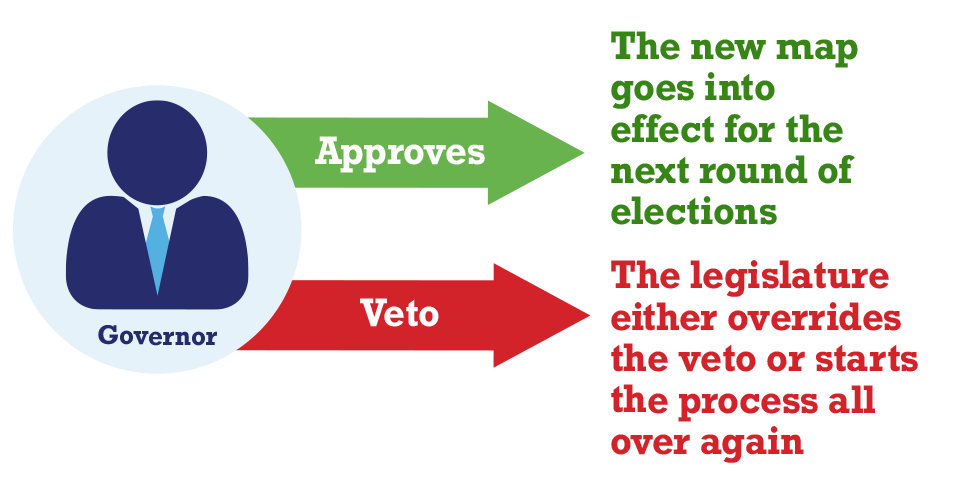
6
Once the legislature agrees on a map, it is sent to the Governor who can approve or veto it. If the Governor and legislature can’t ultimately agree on a map, the State Supreme Court takes over the redistricting process

Louisiana Legislature
- U.S. Congress
- State Senate & House
- State Supreme Court
- Board of Elementary and Secondary Education (BESE)
- Public Service Commission (PSC)

- The public plays a key role in determining how the redistricting process plays out and how the district lines are ultimately drawn.
- Submit comments during public redistricting hearings.
- Anyone can do it.
Local Governments
- City Council
- Parish Council
- Police Jury
- Judicial


